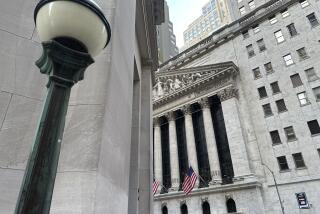Bond Portfolios Finish in the Red
- Share via
The bond market was full of surprises in the first quarter, nearly all of them unpleasant.
Market interest rates jumped, devaluing older bonds issued at lower rates.
And shorter-term rates rose faster than longer-term rates, which meant that the strategy of favoring shorter-term bonds over the longest-term issues -- normally a risk-reducing tactic -- backfired for many investors.
In the corporate bond sector, high-yield securities demonstrated why they sometimes live up to their nickname -- junk.
Overall, investors demanded higher rates, or yields, on new bonds as the quarter progressed, spurred by an inflation scare and by some unsettling comments from Federal Reserve Chairman Alan Greenspan.
By March 31, the annualized yield on the benchmark 10-year Treasury note was 4.48%, up from 4.22% at year-end and 3.99% on Feb. 9.
As rates on new bonds rise, older bonds issued at lower fixed rates decline in value. So the typical bond mutual fund suffered a loss of principal value in the quarter ended March 31. That was offset somewhat by interest earned.
The important number for bond fund investors is “total return” -- interest earnings plus or minus the change in value of their principal. The average fund that owns government bonds had a negative total return of 0.4% in the quarter, according to Morningstar Inc. The average corporate-bond fund lost 0.7% in the period. Foreign bond funds lost 1.7%, on average, in part because of the stronger dollar.
Those losses were much smaller than the 2.6% decline in the average U.S. stock fund. And a pullback in bond yields in recent days has made up for some of the quarter’s pain.
Still, financial advisors say bond investors should view the first three months as a warning.
“People need to look at their bond holdings and how they’re invested,” said Geordie Crossan, president of NBS Financial Services Inc. in Westlake Village.
If market interest rates were to surge, bond fund losses -- at least on paper -- could be much worse than in the first-quarter.
Bond yields face two potential sources of upward pressure: One is the Fed’s campaign of raising its key short-term rate, now 2.75% after seven quarter-point increases since June.
The other is inflation worries. Inflation erodes the purchasing power of money, so investors in fixed-rate bonds are particularly sensitive to the threat.
Record oil prices in the first quarter boosted inflation fears. The Fed deepened those concerns by warning on March 22 that “pressures on inflation have picked up in recent months.”
Many bond investors also were put off by Greenspan’s comments in mid-February about the level of long-term interest rates compared with short-term rates. Long-term rates are set by the marketplace, while the Fed controls short-term rates.
Just days after the 10-year Treasury note yield briefly fell below 4% on Feb. 9, Greenspan said it was a “conundrum” why long-term yields had declined since June, even as the Fed was raising short-term rates.
Some bond pros say Greenspan wanted to “talk up” long-term yields, to get investors to be more realistic about risks in the market and the economy as the central bank tightens credit.
“He got what he wanted,” said Brian Matthews, a managing principal at investment firm Payden & Rygel in Los Angeles.
In the Treasury market, however, yields rose more dramatically on so-called intermediate-term securities than on the longest-term issues.
The five-year T-note yield jumped from 3.61% on Dec. 31 to 4.17% by the end of March, a rise of 0.56 point. That was more than double the 0.26-point rise in the 10-year T-note yield.
The result: The average intermediate-term government bond fund had a negative total return of 0.4% for the quarter, while the average long-term government fund was unchanged.
Likewise, long-term municipal bond funds held up better than shorter-term muni funds.
Because inflation poses the biggest threat to longer-term bonds, some experts said the relatively muted rise in long-term yields suggested that investors weren’t overly worried about inflation.
That is Matthews’ view. “We don’t see the inflation scare as being as large” as some analysts have warned, he said.
Still, it makes sense for investors to consider what could go wrong for bonds, Crossan said. A sustained rise in inflation could hit longer-term bonds much harder than shorter-term issues, the first quarter notwithstanding, he said.
And if the economy were to deteriorate, funds that own lower-quality bonds -- such as corporate junk issues -- could face bigger losses than those suffered in the first quarter, when the average junk bond fund had a negative total return of 1.5%.
Didi Weinblatt, manager of the USAA Income fund in San Antonio, said she recently bought some inflation-protected Treasury bonds for her portfolio, to add some inflation insurance.
But for the most part, she said, diversification among government, corporate and mortgage bonds -- and in varying maturities -- is what held her fund to a 0.1% first-quarter loss.
The challenge now, she said, is deciding when it’s time to lock in higher yields. Historically, longer-term interest rates often have crested before the Fed was done boosting short rates. Although it may be early to call a peak in longer-term bond yields, the first-quarter run-up means “it’s probably a better time to buy bonds than it has been” in a while, Weinblatt said.
More to Read
Inside the business of entertainment
The Wide Shot brings you news, analysis and insights on everything from streaming wars to production — and what it all means for the future.
You may occasionally receive promotional content from the Los Angeles Times.










